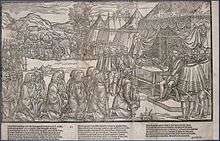Turlough Luineach O'Neill
Turlough Luineach O'Neill (Irish: Toirdhealbhach Luineach Mac Néill Chonnalaigh Ó Néill, or Turlough, fostered by the O'Lunaigh family; son of Neill Chonnalaigh O'Neill) (1532 – September, 1595), was an Irish Gaelic lord of Tyrone in medieval Ireland. He was inaugurated upon Shane O’Neill’s death, becoming The O'Neill.
Birth and ancestry
Turlough was born around 1530 at Seanchaisleán close to the modern town of Newtownstewart. He was the fourth son of Niall Connallach macArt óg O'Neill, Tanist of Tyrone (1519–1544). As Tanist, Niall Connallach was designated to succeed his uncle Conn Bacach mac Conn, The O'Neill (1519–1559). Turlough's mother may have been Niall Connallach's wife, Rose O'Donnell, the daughter of Manus, The O'Donnell of the kingdom of Tir Conaill (Donegal). Turlough was the grandson of Art óg macConn, The O'Neill (1513–1519) and was a direct descendant of Brian macNéill Ruad, The O'Neill and ruler of Tír Eóghain (Tyrone) (1238–1260), considered by the Irish to be King of Ulster (1241–1260) and the last High King of Ireland (1258–1260).
Turlough as "The O'Neill"
Making professions of loyalty to the Queen of England in the year following Shane's assassination, Turlough sought to strengthen his position by alliance with the O’Donnells, MacDonnells and MacQuillans. But his conduct giving rise to suspicions, an expedition under Walter Devereux the earl of Essex was sent against him, which met with such doubtful success that in 1575 a treaty was arranged by which O’Neill received extensive grants of lands and permission to employ three hundred Scottish mercenaries. A further treaty in 1578, negotiated by Lady Agnes, confirmed Turlough’s vast land holdings in Ulster, granted him a Knighthood and the British titles of Earl of Clanconnell and Baron of Clogher, for life, and allowed him to retain for life the personal army of Scottish mercenaries negotiated three years before.

Still, at the outbreak of rebellion in Munster his attitude again became menacing, and for the next few years he continued to intrigue against the English authorities through clandestine alliances with Spain and Scotland, yet he maintained virtual control of Ulster until 1593, when he was forced by poor health and military setbacks to concede power to his principal rival, Hugh, brother of Brian, whom Turlough had assassinated in 1562 during Shane O’Neill's absence at the court of Queen of England. Hugh was recognised by Turlough as captain of Tyrone, and as his Tanist, in 1593. During the summer of 1595 Hugh seized the last castle still held by Turlough, razed it, and drove Turlough into the wilderness. He died between 9 and 12 September, and was buried at Ardstraw, probably at the Franciscan Friary founded by his ancestors.
Turlough Luineach had successfully survived as "The O'Neill" from 1567 until 1593, a turbulent quarter century that saw the most concerted efforts by the English administration to weaken and marginalise his authority in Ulster. He is frequently depicted by contemporary English historians as a weak, drunken buffoon, but his continued survival as the O'Neill through this period speaks of his considerable skill as a ruler and of a sustained policy of successful compromise.
Patron of the Arts
Turlough has the distinction of being one of the most highly praised rulers by the Gaelic poets and musicians of his time. His father Niall Connallach had been a celebrated patron of the arts and Turlough avidly followed his example. He sheltered Uilliam Nuinseann when the poet was accused of conspiracy in the Baltinglass rebellion of 1580.
Family
His wife Agnes Campbell was daughter of Colin Campbell, 3rd Earl of Argyll. One of his daughters was married, as his second wife, to Sorley Boy MacDonnell when he was past the age of eighty years. Another daughter was married to Donnell O'Donnell, a leading figure in Tyrconnell until his death at the Battle of Doire Leathan in 1590. Turlough's successor was his son Sir Arthur O'Neill, although Arthur did not succeed him as head of the O'Neills. During Tyrone's Rebellion, Arthur initially sided with his distant cousin the Earl of Tyrone, but then switched sides and served with Sir Henry Docwra's forces out of Derry until his death in 1600. Arthur was then succeeded by his own son, Turlough O'Neill.
See also
References
 This article incorporates text from a publication now in the public domain: Chisholm, Hugh, ed. (1911). "O'Neill". Encyclopædia Britannica (11th ed.). Cambridge University Press.
This article incorporates text from a publication now in the public domain: Chisholm, Hugh, ed. (1911). "O'Neill". Encyclopædia Britannica (11th ed.). Cambridge University Press.- Proinsias Ó Conluain "Dutiful Old Knight and Formidable Foe", Dúiche Néill, No. 13, 2000, pgs. 9–48.
- Hiram Morgan, Tyrone's Rebellion, The Royal Historical Society & The Boydell Press, Woodbridge, 1993.
- H.C.Hamilton, E.G. Atkinson and R.P. Mahaffy (eds) Calendar of State Papers Ireland, 24 Vols, London, 1860–1912.